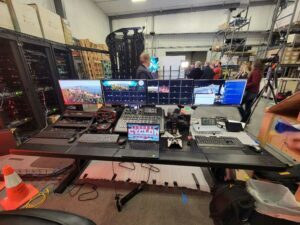In creating complex, high-performance extended reality(Hi-PerXR™) environments that can meet the needs of multiple users, it’s critical to partner with a technology provider who understands the full array of challenges that will have to be addressed.
This is an environment, after all, where the traditional rules for theater display and presentation systems go out the window. Not only are users much closer to the displays, but the system surrounds them. Moreover, the graphics-intensive nature of the system and the deep interaction that occurs between user and data place unique demands on the integration. Those charged with delivering high performance extended reality systems that can include VR, AR, and MR technologies, experience need both a keen understanding of the intended use cases and the ability to integrate all the components into a high-performing whole.
“Detail is everything,” says Mechdyne 3D display technology consultant Kurt Hoffmeister. “If the compute system driving the display is being taxed, it will have trouble reproducing the full resolution in sufficient detail. If the display rate begins to drop, it can’t draw as many new images per second as are needed for a satisfying interaction. Likewise, if the graphics are good but the frame is ‘chunky,’ or moves in steps instead of smoothness, that distracts from the experience and breaks down the sense of immersion.”
The consequences of poor fidelity and inadequate frame rates can be more than distracting. They can lead to disorientation and what’s called “simulator sickness,” which is akin to motion sickness.

The right technology partner will ensure you build in the correct amount of computing power, and harness it in an optimal manner, to fit the client’s workflow. “This is crucial,” says Hoffmeister. “Mechdyne’s success in creating high-value virtual reality environments rests in large part on our ability to create systems that effectively accommodate users’ workflows, rather than forcing them to bend to the technology.”
Engaging the services of a partner with documented, end-to-end expertise in complex VR system design and integration has another benefit as well. “The client can take advantage of lessons learned, and possibilities realized, from their technology provider’s work on other projects,” explains Chad Kickbush. A record of success in bringing XR to a wide range of clients in a breadth of industries is powerful evidence of an ability to tailor the technology to the particularities of each use case.
“It’s also desirable,” adds Kickbush, “to have a vendor-neutral partner who’s open to all available hardware and software options and has the real-world experience to look beyond published specs and recommend what’s actually going to work.” A technology partner that lacks real-world experience in designing, integrating and servicing complex XR may not have the depth of understanding on how best to realize their client’s vision. That creates the possibility of false starts, prolonged timelines, last-minute system modifications, and worse. “The last thing you want is a system that doesn’t fully realize the potential of your technology investment,” Kickbush says. “The right partner will have the big-picture understanding combined with the detailed knowledge necessary to ensure peak performance.”
The big takeaway for those who want to tap into the power of virtual reality is not to settle for a prospective technology partner who offers a cookie-cutter approach to complex VR. It might be tempting to adopt a more templated system vs. one created to meet your unique needs, but any cost savings are apt to be demolished by the tradeoffs that come from forcing users to change fundamental aspects of how they work.

“It’s critically important to understand the interdependent nature of XR solutions. Brute-force computing power only goes so far in creating effective 3D immersive facilities,” says Mechdyne XR solutions architect Gary Quasebarth. “When you’re looking at true 3D immersive visualization, understanding the eye-tracking, the intricacies of rendering, and the particular challenges of GPU clustering requires specialized expertise – something we’ve amassed over 25 years. We actually invented clustering of PC and GPUs to correctly render canvases for the Unity gaming engine, and we’ve also pioneered distributed clustering to enable far-flung use groups to experience the same content.”
The combination of power and finesse that the right technology partner brings to XR is elemental to its success. ROI will be even greater if that partner has the resources to ensure that the end user will be at home with the system. To this end, Mechdyne provides onsite personnel to guide clients not only at system launch but at any time such expertise is needed. They may be on hand for a few weeks or months or return after a few years to provide education, perform maintenance, convert content, and help to tailor the system for new use cases.
 It’s important to remember the unique technological and operational requirements of complex XR environments. “Being able to render 3D content on a tablet or TV is one thing,” Quasebarth says. “But if you take it to large canvases, you need exponentially more horsepower. Now, hardware manufacturers like Nvidia and Silverdraft have always been high-performance GPU companies. The difference is that today’s graphics require more power than ever before and will have to be easier to use than ever.” Combine those requirements with the need for scalability and flexibility to accommodate multiple users and optimize ROI.
It’s important to remember the unique technological and operational requirements of complex XR environments. “Being able to render 3D content on a tablet or TV is one thing,” Quasebarth says. “But if you take it to large canvases, you need exponentially more horsepower. Now, hardware manufacturers like Nvidia and Silverdraft have always been high-performance GPU companies. The difference is that today’s graphics require more power than ever before and will have to be easier to use than ever.” Combine those requirements with the need for scalability and flexibility to accommodate multiple users and optimize ROI.
“The single best advice I can provide,” says Quasebarth, “is to partner with a pro who can translate your strategic objectives into a system robust enough to power your progress.”


